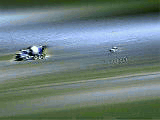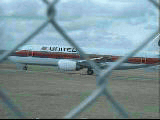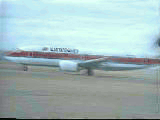Linear-Trajectory Filtering
Norm Bartley
We have employed simple 3-D inductance-resistance (LR) networks
as the basis of 3-D recursive digital filtering algorithms for
enhancing a fundamental class of 3-D spatiotemporal-domain
signals, namely linear-trajectory signals. Such signals
encompass objects of constant size, shape and intensity that move
in a straight line at constant speed when viewed, say, on a
television screen. Linear-trajectory filtering is then to
selectively enhance such objects on the basis of their direction
and speed.
Below are some input and output images from a couple of our
linear-trajectory filtering examples.
Our first work in this area is described in
this paper.
The Cement Truck
 Shown here is a single frame of
an image sequence filmed on a busy roadway near the University
of Calgary. If you wish to view an MPEG-encoded segment of the moving
image sequence, please play the
input traffic sequence (330K,
160x120, 100 frames).
The moving vehicles in this sequence all represent
good examples of linear trajectory signals.
We can choose the
parameters of the LR prototype network to selectively enhance vehicles
moving at a particular velocity in this sequence.
Shown here is a single frame of
an image sequence filmed on a busy roadway near the University
of Calgary. If you wish to view an MPEG-encoded segment of the moving
image sequence, please play the
input traffic sequence (330K,
160x120, 100 frames).
The moving vehicles in this sequence all represent
good examples of linear trajectory signals.
We can choose the
parameters of the LR prototype network to selectively enhance vehicles
moving at a particular velocity in this sequence.
 Shown at left is a single frame of
the filtered sequenced obtained from a linear-trajectory filter
designed to enhance vehicles having the velocity
of the cement truck. Please play the MPEG-encoded
output traffic sequence (142K,
160x120, 100 frames).
You will notice that all objects moving at speeds other than
that of the cement truck, including
the static background and vehicles in the lane of oncoming traffic,
have been attenuated. The cement truck, and also the car beginning
to overtake it, are clearly visible. This seqeuence was presented
by Len Bruton in his Keynote Address at the 1990 Midwest Symposium
on Circuits and Systems here in Calgary and the still images at
left are featured on the cover of the conference proceedings.
Shown at left is a single frame of
the filtered sequenced obtained from a linear-trajectory filter
designed to enhance vehicles having the velocity
of the cement truck. Please play the MPEG-encoded
output traffic sequence (142K,
160x120, 100 frames).
You will notice that all objects moving at speeds other than
that of the cement truck, including
the static background and vehicles in the lane of oncoming traffic,
have been attenuated. The cement truck, and also the car beginning
to overtake it, are clearly visible. This seqeuence was presented
by Len Bruton in his Keynote Address at the 1990 Midwest Symposium
on Circuits and Systems here in Calgary and the still images at
left are featured on the cover of the conference proceedings.
Taxiing Aircraft
 Another example of
linear-trajectory filtering is for the image shown at left.
This is a single frame of a sequence obtained by recording a
taxiing aircraft through a chain link fence. Please play
the MPEG-encoded input moving sequence
(215K, 160x120, 100 frames). There
are two important linear trajectory signals here; one is the
aircraft, which is appears stationary in the image, and the other
is the moving fence.
Another example of
linear-trajectory filtering is for the image shown at left.
This is a single frame of a sequence obtained by recording a
taxiing aircraft through a chain link fence. Please play
the MPEG-encoded input moving sequence
(215K, 160x120, 100 frames). There
are two important linear trajectory signals here; one is the
aircraft, which is appears stationary in the image, and the other
is the moving fence.
 At left is a single frame of the
output sequence obtained from a linear-trajectory filter designed for
enhancing zero-velocity signals.
The aircraft is a zero-velocity signal, so it is transmitted by
the filter without serious distortion. All objects that move, including the
ground and particularly the fence, are rejected or severely
smeared. Please play the MPEG-encoded
output sequence (149K,
160x120, 100 frames).
At left is a single frame of the
output sequence obtained from a linear-trajectory filter designed for
enhancing zero-velocity signals.
The aircraft is a zero-velocity signal, so it is transmitted by
the filter without serious distortion. All objects that move, including the
ground and particularly the fence, are rejected or severely
smeared. Please play the MPEG-encoded
output sequence (149K,
160x120, 100 frames).
 Shown here is a single frame of
an image sequence filmed on a busy roadway near the University
of Calgary. If you wish to view an MPEG-encoded segment of the moving
image sequence, please play the
input traffic sequence (330K,
160x120, 100 frames).
The moving vehicles in this sequence all represent
good examples of linear trajectory signals.
We can choose the
parameters of the LR prototype network to selectively enhance vehicles
moving at a particular velocity in this sequence.
Shown here is a single frame of
an image sequence filmed on a busy roadway near the University
of Calgary. If you wish to view an MPEG-encoded segment of the moving
image sequence, please play the
input traffic sequence (330K,
160x120, 100 frames).
The moving vehicles in this sequence all represent
good examples of linear trajectory signals.
We can choose the
parameters of the LR prototype network to selectively enhance vehicles
moving at a particular velocity in this sequence.
 Shown at left is a single frame of
the filtered sequenced obtained from a linear-trajectory filter
designed to enhance vehicles having the velocity
of the cement truck. Please play the MPEG-encoded
Shown at left is a single frame of
the filtered sequenced obtained from a linear-trajectory filter
designed to enhance vehicles having the velocity
of the cement truck. Please play the MPEG-encoded
 Another example of
linear-trajectory filtering is for the image shown at left.
This is a single frame of a sequence obtained by recording a
taxiing aircraft through a chain link fence. Please play
the MPEG-encoded input moving sequence
(215K, 160x120, 100 frames). There
are two important linear trajectory signals here; one is the
aircraft, which is appears stationary in the image, and the other
is the moving fence.
Another example of
linear-trajectory filtering is for the image shown at left.
This is a single frame of a sequence obtained by recording a
taxiing aircraft through a chain link fence. Please play
the MPEG-encoded input moving sequence
(215K, 160x120, 100 frames). There
are two important linear trajectory signals here; one is the
aircraft, which is appears stationary in the image, and the other
is the moving fence.
 At left is a single frame of the
output sequence obtained from a linear-trajectory filter designed for
enhancing zero-velocity signals.
The aircraft is a zero-velocity signal, so it is transmitted by
the filter without serious distortion. All objects that move, including the
ground and particularly the fence, are rejected or severely
smeared. Please play the MPEG-encoded
At left is a single frame of the
output sequence obtained from a linear-trajectory filter designed for
enhancing zero-velocity signals.
The aircraft is a zero-velocity signal, so it is transmitted by
the filter without serious distortion. All objects that move, including the
ground and particularly the fence, are rejected or severely
smeared. Please play the MPEG-encoded